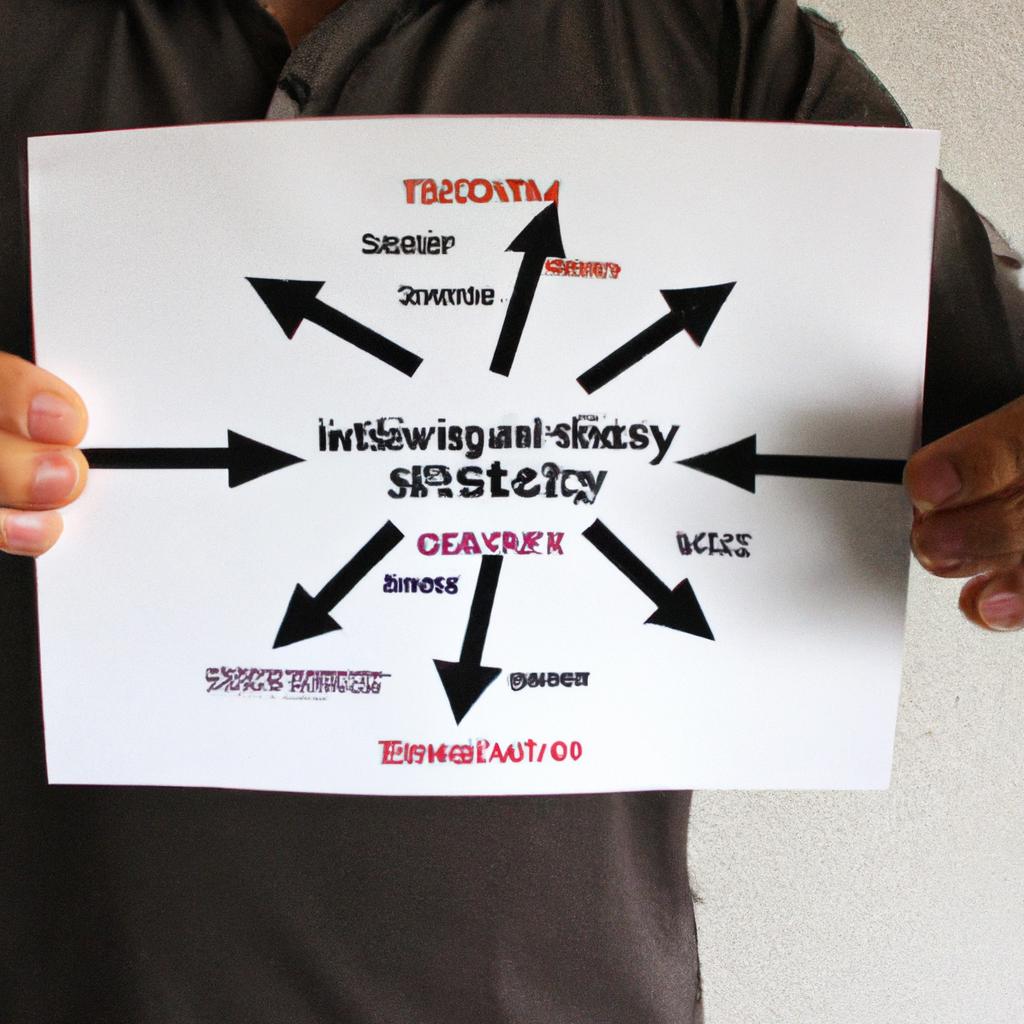In the competitive landscape of marketing and advertising, effectively identifying and targeting the right audience is crucial for achieving success. This process is known as product positioning, wherein marketers strategically position their products or services in the minds of consumers to create a distinct image and appeal. Understanding the target audience plays a vital role in determining how to communicate with them effectively and develop marketing strategies that resonate.
To illustrate this concept, let us consider the case of XYZ Electronics, a company specializing in high-end audio equipment. In an effort to expand its market share, XYZ Electronics underwent extensive research to identify their target audience. Through surveys, focus groups, and data analysis, they discovered that their primary customers were audiophiles – individuals who have a deep appreciation for superior sound quality. Armed with this knowledge, XYZ Electronics was able to tailor their advertising campaigns towards showcasing the exceptional audio performance of their products and highlighting features that appealed specifically to audiophile enthusiasts.
By understanding their target audience’s preferences and needs, companies can position their products in ways that differentiate them from competitors and attract customers’ attention. This article aims to explore various aspects of target audience identification and product positioning within marketing and advertising strategies. By delving into topics such as consumer segmentation techniques, effective messaging approaches, and leveraging consumer insights to inform product development, marketers can gain valuable insights that drive successful positioning strategies.
One crucial aspect of target audience identification is consumer segmentation. This involves dividing the overall market into distinct groups based on similar characteristics, such as demographics, psychographics, behavior, or preferences. By segmenting the market, marketers can better understand the specific needs and desires of different customer groups and develop tailored marketing strategies to reach them effectively. For example, XYZ Electronics may identify audiophiles as a specific segment within the broader market of audio equipment consumers.
Once the target audience is identified and segmented, effective messaging becomes essential in communicating with them. Marketers need to craft messages that resonate with their audience’s values and aspirations while highlighting the unique benefits of their products or services. For XYZ Electronics targeting audiophiles, their messaging could focus on technical specifications like frequency response range or signal-to-noise ratio to demonstrate superior sound quality.
Leveraging consumer insights is another critical factor in product positioning. Marketers should gather data from various sources like surveys, social media listening tools, or customer feedback to gain a deep understanding of their target audience’s preferences, behaviors, and pain points. These insights can guide decision-making processes across all aspects of marketing – from product development to pricing strategies to distribution channels.
In conclusion, effective product positioning requires a thorough understanding of the target audience. By identifying specific customer segments through segmentation techniques and crafting compelling messages informed by consumer insights, marketers can position their products or services in ways that differentiate them in the competitive landscape and resonate with customers’ needs and desires.
Understanding Target Audience
To effectively position a product in marketing and advertising, it is crucial to have a deep understanding of the target audience. By identifying the specific characteristics and preferences of the intended consumers, marketers can tailor their strategies and messages accordingly. For instance, let us consider a hypothetical scenario where a company is launching a new line of luxury skincare products targeting affluent women aged 35-50. Understanding this target audience will allow marketers to create compelling advertisements that resonate with their desires for youthful-looking skin and exclusivity.
There are several key factors to consider when analyzing the target audience:
-
Demographics: This includes age, gender, income level, education level, marital status, and occupation. These demographic traits provide valuable insights into consumer purchasing power, lifestyle choices, and potential brand affiliations.
-
Psychographics: Psychographic information delves deeper into the psychological aspects of the target audience’s behavior and attitudes. It encompasses interests, values, opinions, hobbies, personality traits, and lifestyles. Knowing these psychographic details allows marketers to craft persuasive messages that align with consumers’ beliefs and aspirations.
-
Behavior patterns: Analyzing how consumers behave in relation to the product category helps identify purchase motivations and decision-making processes. Factors such as frequency of purchases, loyalty towards certain brands or retailers, online shopping habits versus offline shopping preferences all contribute to understanding consumer behavior better.
-
Consumer needs: Recognizing the unmet needs or pain points within the target market enables businesses to develop unique selling propositions (USPs) that address those concerns directly. Whether it be convenience-driven solutions or eco-friendly alternatives – fulfilling customer needs contributes significantly to successful product positioning.
By incorporating these elements into comprehensive market research efforts – including surveys, focus groups, data analysis from social media platforms – companies can gain valuable insight into their target audience’s preferences and behaviors.
Moving forward into “Identifying Market Segments,” we will build upon this foundation by exploring how to group consumers into distinct segments based on shared characteristics and needs.
Identifying Market Segments
Having gained a comprehensive understanding of the target audience, it is now essential to move forward in identifying market segments that align with the product positioning strategy. To illustrate this process, let us consider an example.
Example:
Imagine a company that specializes in producing luxury cars. They want to position their latest model as an exclusive choice among affluent individuals who value both style and performance. In order to effectively reach this target audience, the company must identify specific market segments that exhibit these characteristics.
Identifying market segments involves segmenting the overall population into groups based on certain shared characteristics or behaviors. By doing so, marketers can tailor their marketing messages and strategies to resonate more effectively with each segment’s unique needs and preferences. Here are several key considerations when identifying market segments:
- Demographics: Analyzing demographic factors such as age, gender, income level, education level, and occupation helps determine which segments may be most interested in the product.
- Psychographics: Examining psychographic variables like lifestyle choices, interests, values, opinions, and attitudes allows for a deeper understanding of consumer motivations and desires.
- Behavior: Assessing past purchase behavior and consumption patterns provides insights into customer loyalty, brand affinity, and potential purchasing decisions related to the product.
- Geographic location: Segmenting markets by geographic factors enables companies to target consumers within specific regions or areas where there is a higher likelihood of finding their desired target audience.
| Market Segment | Key Characteristics | Consumer Motivations |
|---|---|---|
| Young adults | Tech-savvy | Desire for convenience |
| Families | Budget-conscious | Need for affordability |
| Empty nesters | Luxury-oriented | Focus on comfort |
| Professionals | Career-driven | Aspiration for success |
By understanding the target audience and conducting thorough market segmentation, companies can develop targeted marketing strategies that resonate with specific consumer groups. This approach allows businesses to maximize their marketing efforts by tailoring messages and promotions to address the unique needs of each segment.
Transition into subsequent section:
Analyzing consumer behavior provides further insights into how individuals within these market segments make purchasing decisions. By delving into factors such as motivations, decision-making processes, and influences on buying behavior, marketers can refine their strategies even more effectively.
Analyzing Consumer Behavior
In the previous section, we discussed the importance of identifying market segments in product positioning. Now, let’s delve into analyzing consumer behavior to further refine our understanding of our target audience.
To illustrate this concept, consider a hypothetical case study involving a new line of fitness apparel. Through market research and analysis, the company identifies three distinct market segments:
- Fitness enthusiasts: This segment includes individuals who are highly committed to their fitness goals and regularly engage in various exercise activities such as running, weightlifting, and yoga.
- Fashion-conscious consumers: These individuals prioritize style and trends when choosing their clothing and enjoy wearing fashionable attire even during workouts.
- Health-conscious moms: This segment consists of mothers who prioritize comfort and practicality in their clothing choices while maintaining an active lifestyle with their children.
Understanding these different market segments allows the company to tailor its marketing strategies accordingly. By addressing each segment’s unique preferences and needs, they can develop effective communication strategies that resonate with their target audience.
Let’s now explore some key factors to consider when analyzing consumer behavior:
- Lifestyle habits: Understanding how consumers incorporate fitness into their daily lives is crucial for targeting specific segments effectively.
- Motivations: Recognizing what drives individuals to stay fit or adopt healthy lifestyles helps shape messaging that appeals to their personal aspirations.
- Demographics: Factors such as age, gender, income level, and geographic location play significant roles in determining consumer preferences within each segment.
- Psychographics: delving deeper into consumers’ values, interests, attitudes, and opinions enables marketers to create more impactful campaigns that align with their target audience’s beliefs.
By considering these factors together with the identified market segments in mind, companies can design targeted marketing efforts that evoke emotional responses from potential customers.
The next section will focus on developing effective communication strategies that leverage this understanding of consumer behavior for successful product positioning. Transitioning seamlessly into this topic requires recognizing the interdependence of consumer behavior analysis and communication strategy development.
Developing Effective Communication Strategies
Having examined consumer behavior in the previous section, it is now crucial to focus on understanding the target audience for effective product positioning. By identifying and analyzing the characteristics of potential consumers, businesses can tailor their marketing and advertising strategies to resonate with these specific groups.
Example: Let us consider a hypothetical case study of a new fitness tracker entering the market. The company behind this product aims to position it as an essential gadget for health-conscious individuals. To achieve this objective successfully, they need to identify their target audience accurately.
To begin the process of targeting the right audience, marketers must segment potential consumers based on various factors such as demographics, psychographics, and behavioral patterns. This segmentation allows them to create distinct customer profiles that represent different segments within the broader population. By doing so, businesses gain insights into customers’ needs, preferences, motivations, and pain points.
- Personalize communication efforts
- Enhance brand loyalty through targeted messaging
- Increase conversion rates by delivering relevant content
- Optimize marketing budget allocation
| Factor | Example | Impact |
|---|---|---|
| Demographics | Age: 25-40 | Tailor messages accordingly |
| Psychographics | Lifestyle: Active | Create relatable content |
| Behavioral | Purchase history: Gym | Offer promotions related to fitness |
Understanding the target audience enables organizations not only to develop personalized communication strategies but also to evoke emotional responses from consumers. By crafting messages that connect with customers on a deeper level, brands can establish stronger relationships and foster brand loyalty among their desired consumer base.
With a clear understanding of our target audience established, we can now move forward in selecting appropriate advertising channels that effectively reach our intended recipients without wasting resources or effort.
Choosing the Right Advertising Channels
Developing Effective Communication Strategies is crucial for any marketing campaign, but equally important is knowing who your target audience is. Understanding the demographics, psychographics, and behaviors of your target audience allows you to position your product effectively and tailor your messaging accordingly.
For instance, let’s consider a hypothetical scenario where a company is launching a new line of athletic shoes targeting young adults aged 18-24 who are interested in fitness and outdoor activities. By conducting thorough market research, the company discovers that this demographic values sustainability, convenience, affordability, and style when it comes to footwear choices.
To effectively reach this target audience, marketers can utilize various strategies:
- Develop engaging content on social media platforms such as Instagram and TikTok to showcase the sustainable materials used in the shoes.
- Collaborate with popular fitness influencers or athletes to promote the convenience of these shoes during workouts or outdoor adventures.
- Offer limited-time discounts or rewards programs to emphasize affordability while maintaining quality.
- Create visually appealing advertisements that highlight the stylish design elements of the shoes.
By incorporating these strategies into their marketing campaigns, companies increase their chances of resonating with their target audience emotionally and driving purchase decisions. To further illustrate how effective communication strategies can impact product positioning, we can examine the following table showcasing different approaches for two distinct target audiences:
| Target Audience | Approach |
|---|---|
| Busy professionals | Emphasize time-saving |
| features | |
| Highlight productivity | |
| benefits | |
| College students | Showcase trendy |
| aesthetics | |
| Promote versatility | |
As seen above, tailoring communication strategies based on specific target audience characteristics helps create an emotional connection between consumers and products. This connection ultimately influences purchasing behavior by aligning with customers’ desires and aspirations.
In the subsequent section, we will delve into evaluating and adjusting marketing campaigns to ensure that they effectively reach their intended target audience. Understanding how to measure the success of communication strategies allows marketers to make data-driven decisions and optimize future campaigns accordingly.
Evaluating and Adjusting Marketing Campaigns
Having discussed the importance of choosing the right advertising channels, let us now turn our attention to evaluating and adjusting marketing campaigns. This crucial step allows marketers to measure the effectiveness of their strategies and make necessary modifications for optimal results.
To illustrate this process, consider a hypothetical case study involving an online clothing retailer launching a new line targeted at young adults. Initially, the retailer invests heavily in social media advertisements on platforms like Instagram and Snapchat, hoping to capture the attention of their target audience. However, after a few weeks, they notice that despite receiving impressive engagement metrics (likes, comments), these ads are not resulting in significant sales conversions.
-
Analyzing Key Performance Indicators (KPIs)
One essential element when evaluating marketing campaigns is analyzing key performance indicators or KPIs. These measurable values provide insights into various aspects of campaign performance. In our case study example, KPIs might include click-through rates (CTRs), conversion rates, cost per acquisition (CPA), and return on ad spend (ROAS). By closely monitoring these indicators over time, marketers can assess whether their strategies are generating desired outcomes. -
Conducting A/B Testing
Another effective method for evaluating marketing campaigns involves conducting A/B testing. This technique allows marketers to compare two versions of an advertisement or webpage with slight variations to determine which performs better. For instance, our hypothetical clothing retailer could create two different landing pages—one featuring high-quality images and another emphasizing customer testimonials—to test which design leads to higher conversion rates. Through careful analysis of user behavior data collected during these tests, marketers can make informed decisions about optimizing their campaigns. -
Gathering Customer Feedback
In addition to quantitative measures like KPIs and A/B testing, gathering qualitative feedback from customers is invaluable for understanding how they perceive and respond to marketing campaigns. This can be done through surveys, focus groups, or social media listening tools. By actively seeking customer opinions, marketers gain valuable insights into their preferences, pain points, and motivations, enabling them to refine their messaging and positioning accordingly.
Table: Emotional Response Elicitation
| Emotion | Example Scenario |
|---|---|
| Excitement | Customers receiving an exclusive discount offer |
| Trust | Positive testimonials from satisfied customers |
| Frustration | Difficulty navigating a website or checkout process |
| Anticipation | Teaser campaign leading up to a product launch |
As seen in the table above, evoking different emotions in the target audience is crucial for effective advertising. Understanding which emotions resonate with your demographic helps shape compelling marketing messages that drive engagement and conversions.
In conclusion,
Evaluating and adjusting marketing campaigns is a critical step towards achieving desired outcomes. By analyzing key performance indicators (KPIs), conducting A/B testing, and gathering customer feedback, marketers can make data-driven decisions to optimize their strategies. Additionally, understanding the emotional responses elicited by various marketing tactics enables brands to craft impactful messages that resonate with their target audience. With continuous evaluation and adaptation, marketers can ensure their product positioning aligns effectively with their intended market segment.










